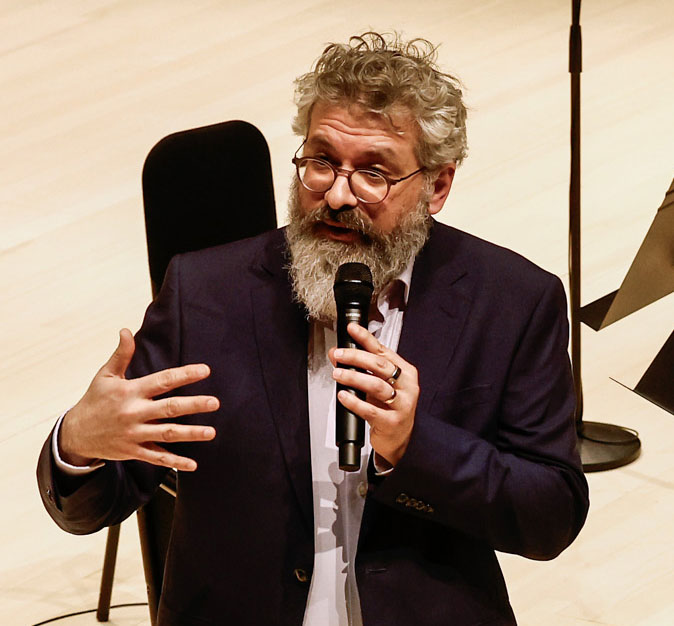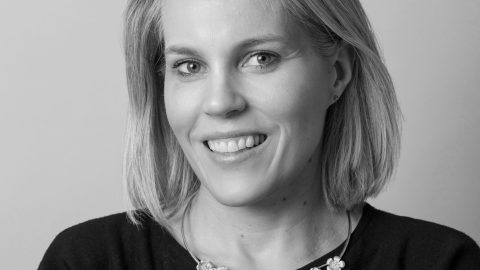“It would be very difficult to teach biology or engineering in a studio designed for dance or music,” Jay Scheib, section head for Music and Theater Arts, told MIT News shortly before the building officially opened. “The same goes for teaching music in a mathematics or chemistry classroom. In the past, we’ve done it, but it did limit us.” He said the new space would allow MIT musicians to hear their music as it was intended to be heard and “provide an opportunity to convene people to inhabit the same space, breathe the same air, and exchange ideas and perspectives.”
The building, made possible by a gift from the late philanthropists Edward ’62 and Joyce Linde, has already transformed daily music life on campus. Musicians, engineers, and designers now cross paths more often as they make use of its rehearsal rooms, performance spaces, studios, and makerspace, and their ideas have begun converging in distinctly MIT ways. Antonis Christou, a second-year master’s student in the Opera of the Future group at the MIT Media Lab and an Emerson/Harris Scholar, says he’s there “all the time” for classes, rehearsals, and composing.
“It’s really nice to have a dedicated space for music on campus. MIT does have very strong music and arts programs, so I think it reflects the strength of those programs,” says Valerie Chen ’22, MEng ’23, a cellist and PhD candidate in electrical engineering who works on interactive robotics. “But more than that, I think it makes a statement that technology and the arts, and music in particular, are very interconnected.”
A building tuned for acoustics and performance
Acoustic innovation shaped every aspect of the building’s 35,000 square feet of space. From the outset, the design team faced a fundamental challenge: how to create a facility where radically different types of music could coexist without interference. Keeril Makan, the Michael (1949) and Sonja Koerner Music Composition Professor and associate dean of MIT’s School of Humanities, Arts, and Social Sciences (SHASS), helped lead that effort.
“It was important to me that we could have classical music happening in one space, world music in another space, jazz somewhere else, and also very fine measurements of sound all happening at the same time. And it really does that,” says Makan. “But it took a lot of work to get there.”

WINSLOW TOWNSON
That work resulted in a building made up of three artfully interconnected blocks, creating three acoustically isolated zones: the Thomas Tull Concert Hall, the Erdely Music and Culture Space, and the Lim Music Maker Pavilion. Thick double shells of concrete enclose each zone, and their physical separation minimizes vibration transfer between them. One space for world music rests on a floating slab above the building’s underground parking garage and is constructed using a box-in-box method, with its inner room structurally isolated from the rest of the building. Other rooms use related techniques, with walls, floors, and ceilings separated by layers of sound-dampening materials and structural isolation systems to reduce sound transmission.
The building was designed by the Japanese architecture firm SANAA, in close collaboration with Nagata Acoustics, the team behind Berlin’s Pierre Boulez Saal. Inspired in part by that German hall, the 390-seat Thomas Tull Concert Hall is meant to serve musicians’ varying acoustic needs. Inside, ceiling baffles and perimeter curtains make it possible to adapt the room on demand, shifting the acoustics from resonant and open for chamber music and classical performances to drier and more controlled for jazz or electronic music.
Makan and the acoustics team pushed for a 50-foot ceiling, a requirement from Nagata for acoustic flexibility and performance quality. The result is a concert hall that breaks from traditional form. Instead of occupying a raised stage facing rows of seats, performers in Tull Hall are positioned at the bottom of the space, with the audience seated around and above them. This layout alters the relationship between listeners and performers; audience members can choose to sit next to the string section or behind the pianist, experiencing sounds and sights typically reserved for musicians. The circular configuration encourages movement, intimacy, and a more immersive musical experience.






Recent Comments